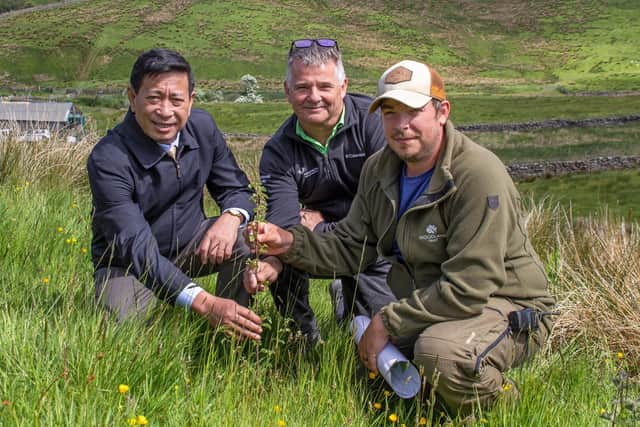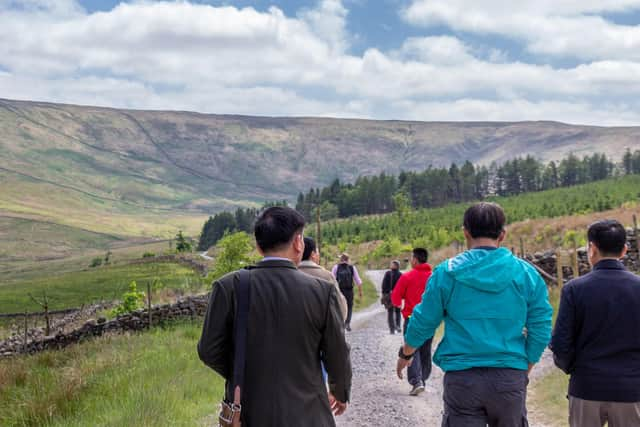New woodland in Yorkshire Dales visited by boss of national park in Vietnam
The director of Phong Nha-Ke Bang National Park, Phạm Hồng Thái, inspected some of the 87,000 saplings planted this past winter at the Woodland Trust’s new 561 hectare ‘Snaizeholme Estate during a two day tour.
Woodland Trust Site Manager Alec Pue led the Vietnamese guests through part of the new woodland.
Advertisement
Hide AdAdvertisement
Hide AdHe explained to the party of four guests: “This was sheep grazing land. A long, long time ago it would all have been woodland. Our aim is to try to kickstart and encourage what would have been here, and then in the long term let natural processes take over.


“The riverside meadows in the valley bottom will be left largely unplanted, as the land is used by wading birds. We also have peatland and limestone pavement which will complement the mosaic of habitats we have on the site.
“Our focus is on nature recovery, but this land is free to roam. People can walk through it. We want to work sensitively and carefully with the local community and the National Park Authority on access.”
The vast and steep fellsides of the woodland creation site in Snaizeholme, about four miles from the town of Hawes, still look like pastures as the saplings are only knee height and – strikingly – not a single plastic tree guard has been used.
Advertisement
Hide AdAdvertisement
Hide AdThe Vietnamese visitors were keen to enquire about the cost of the woodland creation.


Mr Pue explained that each of the saplings cost close to 70p each, including planting and associated costs, with the trees having being sourced from a nursery near Hexham. One of the main costs was installing livestock and rabbit-proof fencing around the long perimeter of the site.
Phạm Hồng Thái said he was excited by the project and would take home ideas for his National Park, where efforts are being made to restore areas affected by illegal logging.
Via an interpreter, he said: “The Yorkshire Dales National Park has a similar geology to Phong Nha-Ke Bang National Park. People visit us for the caves, too. So I wanted to see how the National Park Authority is doing its job here, and how they are managing visitors and helping nature recovery.
Advertisement
Hide AdAdvertisement
Hide Ad“I am excited by what I see here [in Snaizeholme]. It’s a good idea to have trees here, conserve the wildlife and keep the waters in this area.”
The four-person party from Phong Nha-Ke Bang National Park were brought to the Yorkshire Dales National Park by Oxalis Adventure, a tour operator in Vietnam.
Work at Snaizeholme is being funded by the White Rose Forest through its ‘Trees for Climate’ funding programme. Trees for Climate is part of the Department for Environment, Food & Rural Affairs’ ‘Nature for Climate Fund’, which provides grants for woodland creation within all ‘Community Forest’ areas in England.
The land at Snaizeholme was acquired by the Woodland Trust thanks to the generosity of individual supporters, charitable trusts and corporate partners.
Advertisement
Hide AdAdvertisement
Hide AdThe Head of Park Management at the Yorkshire Dales National Park Authority, Alan Hulme, also addressed the tour party during the Snaizeholme visit.
He said: “This Woodland Trust scheme is an exemplar project for adapting to climate change. During heavy rain water comes down fast from Snaizeholme.
"If we can slow water coming off the fells through woodland creation, we can help protect people downstream in cities like York. It’s also a great example of a nature recovery project – restoring a mosaic of different, highly valuable habitats.”
Snaizeholme will become a flagship woodland creation project for the White Rose Forest, the Community Forest for North and West Yorkshire, and the Northern Forest, a partnership between the Woodland Trust and some of the Community Forests in the north of England.
Advertisement
Hide AdAdvertisement
Hide AdThe project as a whole will help achieve the objectives of the ‘Dales Woodland Strategy’, put together by the Dales Woodland Forum.
This strategy sets an ambition to enhance the landscape by creating 60 square kilometres of woodland habitat in the Yorkshire Dales National Park by 2030. That would take the area of the National Park covered by woodland from 4.3 per cent to seven per cent.
